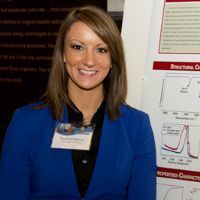

Elisabeth Bianco, a senior chemistry major at Ohio State University, received the $3,000 first place award at the second annual Notre Dame Competition in Nanoscience and Nanoengineering, and Campus Tour (NDConnect).
Bianco won for her exploration of the properties of a one-atom-thick layer of the semiconductor germanium, which she synthesized for the first time and then characterized.
“Only a couple of years ago, the Nobel Prize was awarded to the researchers who developed graphene, a two-dimensional material made of carbon atoms,” says Ken Kuno, associate professor of chemistry and biochemistry at Notre Dame.
“Elisabeth’s work moves beyond graphene by looking at a two-dimensional layer of germanium, which has many interesting properties, including advantages in the development of new transistors for computers.”
Ultrathin materials may seem exotic, but it is through them that Bianco found her calling as a scientist.
“Materials chemistry is my passion,” she says. “It is such an exciting and dynamic field with still so many questions to be answered. I love synthesis, and the synthetic aspect is what makes materials chemistry so elegant and so vital to the rest of the materials field.”
Second place, and a $2,000 award, was won by Ashvin Bashyam, a biomedical engineering senior from the University of Texas at Austin, for his work on using nanosized gold particles to noninvasively detect sentinel lymph nodes, which are thought to be early markers of cancer in the body.
Neil Brown and Hannah Haines, both chemical engineering majors from the University of Tennessee, Knoxville, collaborated and shared the $1,000 third place prize for their research into the manipulation of Photosystem I, a protein complex that is involved in photosynthesis in plants. Their work may one day lead to hybrid solar energy systems that incorporate biological materials.
Dane Wheeler of HRL Laboratories says that he and the other industry judges were impressed by the high quality of the research projects in the competition.
“It was clear that all the students understood the challenges and potential benefits of their work,” Wheeler says. “They displayed genuine enthusiasm, too. This isn't just another summer job; it's a passion to solve problems that no one else has solved.”
On the broad nature of the research, he added, “Judging the competition this year solidified my belief that there are no boundaries, no compartments in nanotechnology research. You can't be just an electrical engineering person, or a materials person, or a chemistry, biology, or nanofabrication person—you have to be a little of each.”
NDConnect brings outstanding undergraduates to Notre Dame’s South Bend, IN, campus to compete for cash prizes and to meet with Notre Dame faculty and researchers.
The event is organized by Notre Dame’s Center for Nano Science and Technology and was hosted this year by the university’s College of Science, College of Engineering, and Graduate School.
Sponsors IBM, HRL Laboratories, Raytheon, and Texas Instruments provided financial support, as well as the judges for the competition.
“We want to put Notre Dame into consideration when students consider where to apply for graduate study in nanoscience and nanotechnology,” says Alan Seabaugh, professor of electrical engineering and organizer of the event.
“I thoroughly enjoyed the visit to Notre Dame,” Bianco says. “The campus is beautiful and everyone I met was welcoming and excited to have us there.”
The competition’s winner says that she will begin her pursuit of a Ph.D. in chemistry next fall, continuing her work in cutting-edge materials research.
Contact: Alan Seabaugh, Alan.C.Seabaugh.1@nd.edu, (574) 631-4473